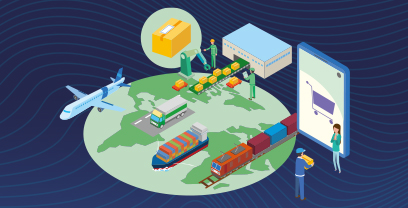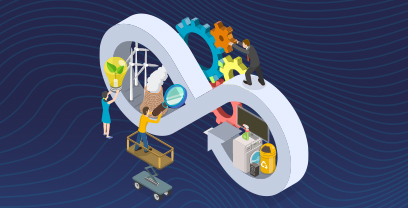Sustainability as a business practice is no longer an optional add-on and sustainable procurement has become a critical component of corporate strategy.
In this blog post, we explore the benefits of sustainable procurement, how companies can reduce their environmental processes, ensure regulatory compliance and best practices for integrating supply chain sustainability in procurement. We will also share how industry leader IKEA implemented sustainable procurement effectively with Ivalua.
What is Sustainable Procurement?
Sustainable procurement is the process of sourcing goods and services in a way that takes into account not only cost and quality but also environmental, social, and governance (ESG) considerations.
It involves integrating sustainability considerations into procurement processes and decisions, to achieve a balanced approach. Sustainability is about meeting the needs of the present without compromising the ability of future generations to meet their own needs.
Environmental sustainability is about preserving natural resources and reducing pollution, while social sustainability focuses on improving quality of life and ensuring social equity. Finally, there’s economic sustainability, which aims at maintaining high, stable levels of economic growth and employment.
Sustainable procurement strategies are critical today, as research shows that supply chains often contribute the most to a company’s environmental impact
Tackling this issue with sustainable procurement policies is not only aligned with customer expectations, it’s morally and ethically sound. There are also significant benefits such as financial savings and improved brand reputation.
Sustainable Procurement at the Forefront of Regulations
As sustainability in procurement becomes increasingly important, sustainable procurement requirements around the world are tightening to ensure businesses are accountable for their environmental and social impacts.
In the EU, the Corporate Sustainability Reporting Directive (CSRD) and the Sustainable Finance Disclosure Regulation (SFDR) require businesses to disclose their environmental, social, and governance (ESG) practices. They also encourage companies to integrate sustainability into their procurement processes, promoting transparency and accountability.
In the USA, the Securities and Exchange Commission (SEC) has proposed rules for climate-related disclosures, requiring publicly traded companies to provide detailed information about their climate risks and emissions. And, in Canada, businesses are expected to adhere to sustainability standards.
Other regulations include the Sustainable Finance Disclosure Regulation (SFDR), which aims to improve transparency in the market for sustainable investment products, and the European Sustainability Reporting Standards (ESRS), which establishes detailed reporting standards for sustainability information, ensuring consistency and comparability of data disclosed by companies under the CSRD.
As a result of these regulations, businesses are now more accountable for their entire supply chain, and procurement teams must take ownership. To that end, they must stay up to date with regulations and ensure supplier compliance by engaging only with suppliers that meet established sustainability criteria.
They must maintain transparent and detailed records of procurement and sustainability activities and supplier practices, and regularly assess and report on sustainability performance of their suppliers.
Learn more in our blog on Securing the Future: The Importance of Sustainable Procurement.
The Three Pillars of Sustainable Procurement
Sustainable procurement is built on three foundational pillars that guide organizations in balancing economic goals with environmental stewardship and social responsibility.
These pillars serve as a framework for integrating Environmental, Social, and Governance (ESG) initiatives into procurement practices, ensuring that purchasing decisions not only meet business needs but also contribute positively to society and the planet.
- Environmental: Implementing sustainable procurement practices involves strategies to reduce environmental impact, such as improving energy efficiency, adopting cleaner technologies, and using renewable energy sources like solar and wind to lower greenhouse gas emissions and carbon footprint. Effective pollution and waste reduction, including recycling and circular economy principles, further mitigate environmental damage. Sourcing products made from renewable or recycled materials also reduces resource depletion and minimizes the environmental footprint.
- Social: The social aspect of sustainable procurement emphasizes ethical practices and social equity. This involves ensuring fair labor conditions, promoting diversity and inclusion in the supply chain, and supporting community development initiatives. By integrating social considerations into procurement strategies, organizations can enhance their reputation and build trust with stakeholders. This approach not only meets the immediate business needs but also fosters a positive impact on society.
- Economic: Economically, sustainable procurement supports long-term economic health by fostering growth through sustainable practices. This includes investing in sustainable technologies and innovations and contributing to local economic regeneration by sourcing from local suppliers, creating jobs, and supporting small and medium-sized enterprises (SMEs).
The Triple Bottom Line Framework
The triple bottom line (TBL) framework expands the traditional reporting framework to include social and environmental performance in addition to financial performance, emphasizing that companies should commit to measuring their impact in three areas:
- People (Social Impact): Companies should evaluate how their operations affect employees, suppliers, customers, and communities.
- Planet (Environmental Impact): Companies should assess and minimize their environmental footprint.
- Profit (Economic Impact): Companies should not only focus on generating financial returns but also ensure that their economic activities contribute to sustainable economic growth.
How can organizations achieve these goals? Companies can promote positive outcomes by integrating the TBL framework into their business strategies and operations:
- Report on social, environmental, and financial performance to stakeholders
- Invest in research and sustainable development to create sustainable products and services
- Implement Corporate Social Responsibility (CSR) programs
- Work with suppliers to enhance their sustainability practices
Learn more in our blog Creating a Circular Economy: Solutions for a Sustainable Supply Chain.
Procurement’s Growing Role in Ensuring Sustainability
Procurement is increasingly responsible for driving enterprise-wide sustainability. Why? Because procurement teams influence the entire supply chain.
According to the US EPA Supply Chain Guidance, procurement involves engaging suppliers to adopt sustainable practices, selecting products and services with minimal environmental impact, and adopting sustainable purchasing practices that support ethical labor and minimize waste.
These efforts ensure compliance with sustainability criteria and promote transparency within the procurement and supply chain. Procurement can achieve sustainable supply chains through various methods:
- Collaborating with suppliers, setting clear sustainability criteria and conducting regular audits to ensure compliance.
- Providing training and resources to suppliers to enhance their sustainability performance.
- Prioritizing eco-friendly products and conducting lifecycle assessments
Purchasing practices should also emphasize sustainability. Improving demand planning and inventory management helps in reducing waste, while optimizing logistics and transportation can lower carbon emissions.
Procurement leaders play a major role in making this happen by facilitating cross-departmental collaboration and enforcing key performance indicators (KPIs) for sustainability performance.
According to Vishal Patel, VP of Producement Marketing at Ivalua, “Sustainable procurement at the organizational level involves integrating Environmental, Social and Governance (ESG) factors into procurement policies and processes, and collaborating with suppliers according to sustainable strategies.”
Read Vishal’s blog post, “Securing the Future: The importance of Sustainable Procurement.”
Download “The Race Towards Carbon Neutrality: Procurement on the Frontline,” to learn how procurement leads the way in sustainability.
Key Elements of Sustainable Procurement
A World Economic Forum analysis in 2021 found more than 50% of global CO2 emissions are concentrated in the supply chains of just eight industries. That’s a staggering number, and organizations must take action.
Achieving sustainable procurement begins with selecting the right suppliers. It’s important to conduct rigorous evaluations based on environmental and social practices. Suppliers with robust sustainability policies and transparent operations help companies minimize their ecological footprint and enhance ethical standards.
Understanding and managing a company’s carbon footprint is another vital component of a sound sustainable procurement strategy. Accurately measuring emissions – in particular Scope 3 emissions from up- and downstream activities – helps companies identify areas for improvement and implement strategies to reduce their environmental impact. Collaboration is also essential. Working together, companies and suppliers can share knowledge, resources, and innovations to create a more integrated and sustainable supply chain.
And last but not least, there’s innovation. Companies and suppliers should work together to identify opportunities to create low-carbon technologies and sustainable solutions.
The Global Reporting Initiative (GRI) Standards, particularly GRI 204: Procurement Practices 2016, provide a comprehensive framework for reporting on procurement practices. These standards help companies disclose their sustainability efforts in a structured and comparable manner, ensuring accountability and continuous improvement.
Read our blog post on how Procurement must own Scope 3 data collection for emissions.
The Benefits of Sustainable Procurement
Sustainable Procurement offers numerous advantages beyond regulatory compliance, significantly enhancing overall performance and societal impact:
- By prioritizing suppliers who uphold high environmental and social standards, companies improve their CSR, demonstrating ethical business practices and meeting stakeholder expectations. This leads to increased loyalty and support.
- Environmentally, sustainable procurement reduces carbon footprints, conserves resources, and minimizes waste, promoting eco-friendly materials and technologies to support climate change efforts.
- Financially, sustainable procurement practices can reduce costs by 9-16% through improved efficiency and better resource management, while mitigating risks related to regulations and supply chain disruptions.
- Sustainable procurement enhances brand reputation and consumer perception, as well, since informed consumers prefer companies with sustainable practices. This approach attracts new customers, strengthens existing relationships, and draws socially responsible investors.
- 5 Best Practices for Implementing Sustainable Procurement Strategies
By implementing the following 5 sustainable procurement best practices, organizations can achieve sustainability in procurement and drive positive environmental, social, and economic outcomes:
- Integrate Sustainable Procurement into Existing Processes: Embed sustainability criteria into every stage of the procurement lifecycle. Begin by establishing clear policies that mandate the consideration of environmental and social factors in procurement decisions. Modify supplier evaluation processes to include sustainability criteria, and educate your teams about the importance of sustainable procurement. Procurement software that supports sustainability tracking and reporting is extremely valuable for this step.
- Create Incentives: Implement reward systems for procurement teams that successfully integrate sustainability into their purchasing decisions, and provide financial benefits such as cost-sharing for sustainability initiatives or discounts for bulk purchases of eco-friendly products.
- Support Collaboration: Engage in industry-wide collaborations to set sustainability standards and share best practices, and involve stakeholders – employees, customers, and investors – in sustainability efforts to build support and drive collective action.
- Enable Transparency: Require suppliers to provide detailed information about their sustainability practices and performance, and regularly publish sustainability reports that disclose procurement practices. Be sure to conduct third-party audits to verify suppliers’ compliance with sustainability standards.
- Set Measurable Goals and Track Them: Establish specific, measurable, achievable, relevant, and time-bound (SMART) goals for sustainable procurement, and develop key performance indicators (KPIs) to monitor your progress.
Watch the full replay of our panel on sustainable procurement strategies at Ivalua NOW.
Common Challenges in Implementing Sustainable Procurement Solutions
Implementing sustainable procurement strategies presents several challenges for organizations, not the least of which is potential fraud. Driven by their complexity and scale, supply chains are a significant source of fraud and supplier risks — hiding impacts that can negatively affect sustainability performance and reputation CSRD.
As a result of this risk, regulations are on the rise. The European Union’s Corporate Sustainability Reporting Directive (CSRD) mandates companies to report on their sustainability impacts comprehensively.
SEC: Similarly, the US Securities and Exchange Commission (SEC) has proposed climate disclosures that require companies to disclose their climate-related risks and impacts. Germany’s new Supply Chain Due Diligence Act mandates companies to identify and address human rights and environmental risks within their supply chains.
ESG: To overcome these sustainable procurement challenges, organizations can adopt several Environmental, social, and governance (ESG) strategies and solutions.
- Invest in advanced data analytics and supply chain management tools to gain better visibility into supply chains and identify areas of risk and improvement.
- Build strong relationships with suppliers and engage in collaborative sustainability initiatives to mitigate risks and enhance compliance.
- Develop clear sustainability criteria for supplier selection and evaluation, ensuring that suppliers are aligned with their sustainability goals.
- Leverage third-party certifications and audits to provide independent verification of suppliers’ sustainability practices.
- Hold regular training sessions, workshops, and awareness programs for employees to help build a culture of sustainability.
Watch this webinar on the impact CSRD will have on Procurement
IKEA’s Approach to Sustainable Supply Chains
One of the best sustainable procurement examples is IKEA, a company that has long been recognized for its commitment to sustainable sourcing, particularly within its supply chain.
According to Slawomir Pter, Supply Chain Development Area Manager at IKEA, Ivalua was a key player in helping them achieve their goals. “Ivalua was instrumental in creating transparency for the whole supply chain,” he said.
Watch this short video to learn how the company’s comprehensive approach ensures its operations are environmentally responsible and socially equitable.
For those interested in learning more about sustainable procurement, Ivalua partnered with IKEA and Capgemini to host an insightful webinar on creating sustainable supply chains the IKEA way. Watch it on-demand to learn:
- How Capgemini is advancing towards its ambitious net-zero objectives.
- IKEA’s goals in product circulation and efforts to decrease their climate footprint
- How IKEA’s supplier code of conduct governs IKEA’s sustainability efforts
Ivalua’s Solutions for Sustainable Procurement
Ivalua provides a unified platform that empowers companies with insights and collaboration tools essential for sustainable procurement. This platform enables organizations to select diverse, sustainable, and ethical suppliers, ensuring that procurement decisions support ESG initiatives.
Ivalua’s sustainable procurement solutions also includes robust collaboration and monitoring tools to strengthen supplier relationships, track supplier performance and compliance, and ensure that all partners meet the required sustainability standards.
To learn more about how Ivalua can help your organization achieve its sustainability goals, visit the Environmental Impact Center
Conclusion
Sustainable procurement is not just a trend but a vital practice for businesses aiming to reduce their environmental impact and enhance their CSR. By integrating sustainable procurement practices, companies can contribute significantly to global efforts to combat climate change, conserve natural resources, and promote ethical labor practices.
What’s next? It’s time to take action! You can start today by integrating sustainability into your procurement processes and partnering with innovative, environmentally-conscious suppliers.
For more detailed insights and practical strategies, watch our on-demand demo of our Environmental Impact Center Datasheet and explore our Environmental, Social, & Governance (ESG) On-Demand Demo ESG On-Demand Demo. Your commitment to sustainable procurement can make a significant difference for both your business and the planet.




